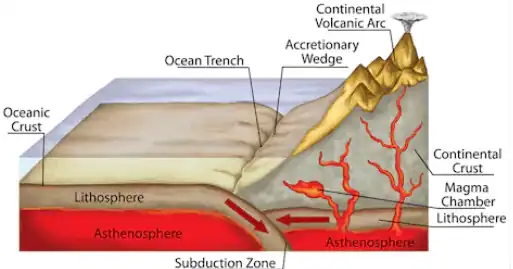
1400 years ago people thought that rocks can fall to the ground and that's it; nobody knew that rocks can sink any further underground. However the Quran portrays rocks that sink further below the surface. Skeptics claim that whoever wrote the Quran made a mistake, rocks on the surface cannot sink any further. Today geologists found rocks that sank more than 400 km below the surface.
The highest point on Earth is in the Himalayas at Mount Everest 8.8 km high. It turned out that this mountain has roots about 250 km deep.
Live Science, Depth of Himalayan Mountain Roots Revealed, 2010


This subduction carries water inside rocks from the surface down to the middle mantle. Scientists found huge amounts of water inside a mineral 410 to 660 km below the surface.
New Scientist, There's as much water in Earth's mantle as in all the oceans, 2017
The high pressure down there breaks down all rocks. But from this discovery we know that the water and rocks from the surface sank more than 400 km beneath Earth's surface. This was known recently, however this was portrayed in the Quran 1400 years before it was discovered.
Then after that your hearts hardened like rocks, or even harder. For there are some rocks from which rivers gush out, and from them that crack and water comes out from them, and from them that descend in awe of Allah. Allah is not unaware of what you do.
٧٤ ثُمَّ قَسَتْ قُلُوبُكُمْ مِنْ بَعْدِ ذَٰلِكَ فَهِيَ كَالْحِجَارَةِ أَوْ أَشَدُّ قَسْوَةً ۚ وَإِنَّ مِنَ الْحِجَارَةِ لَمَا يَتَفَجَّرُ مِنْهُ الْأَنْهَارُ ۚ وَإِنَّ مِنْهَا لَمَا يَشَّقَّقُ فَيَخْرُجُ مِنْهُ الْمَاءُ ۚ وَإِنَّ مِنْهَا لَمَا يَهْبِطُ مِنْ خَشْيَةِ اللَّهِ ۗ وَمَا اللَّهُ بِغَافِلٍ عَمَّا تَعْمَلُونَ
"And from them that descend in awe of Allah" here the rocks and water are descending below the surface but the Quran didn't say "rocks" or "water" anymore because at that depth rocks break down and the water is not liquid anymore but rather in the form of ions inside minerals. If the Quran said that sinking rocks remain intact it would have been a mistake.
HTML Generator